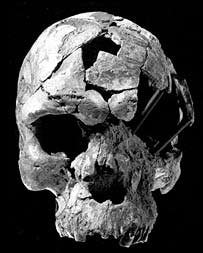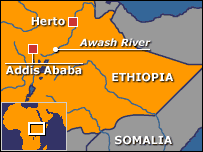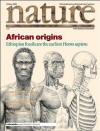Yoruba Mythology
According to Yoruba (YOUR-a-bah) mythology, the first Yoruba kings were the offspring of the creator, Oduduwa (oh-doo-DOO-wah). A Yoruba king's crown identifies the status of its wearer and gives the king the power to interact with the spirit world in order to benefit his people. A veil, a large face, and a group of birds are commonly appear on a Yoruba king's crown.
Long, long ago, Olorun (OH-low-run), the sky god, lowered a great chain from the heavens to the ancient waters. Down this chain climbed Oduduwa, Olorun's son. Oduduwa brought with him a handful of dirt, a special five-toed chicken, and a palm nut. He threw the dirt upon the ancient waters and set the chicken on the dirt. The chicken busily scratched and scattered the dirt until it formed the first dry earth. In the center of this new world, Oduduwa created the magnificent Ife (EE-fay) kingdom. He planted the palm nut, which grew into a proud tree with 16 branches, symbolizing the 16 sons and grandsons of Oduduwa.
Oduduwa was the first ruler of the kingdom and the father of all Yoruba. Over time he crowned his 16 sons and grandsons and sent them off to establish their own great Yoruba kingdoms. As descendants of the sky god, these first Yoruba rulers and their direct descendants were divine kings. Only they could wear special veiled crowns that symbolized their sacred power.
Boshongo
The Boshongo are a Bantu tribe of Central Africa.In the beginning there was only darkness, water, and the great god Bumba. One day Bumba, in pain from a stomach ache, vomited up the sun. The sun dried up some of the water, leaving land. Still in pain, Bumba vomited up the moon, the stars, and then some animals: the leopard, the crocodile, the turtle, and, finally, some men, one of whom, Yoko Lima was white like Bumba.
Efik
The Efik are a Nigerian tribe.The creator, Abassi, created two humans and then decided to not allow them to live on earth. His wife, Atai, persuaded him to let them do so. In order to control the humans, Abassi insisted that they eat all their meals with him, thereby keeping them from growing or hunting food. He also forbade them to procreate. Soon, though, the woman began growing food in the earth, and they stopped showing up to eat with Abassi. Then the man joined his wife in the fields, and before long there were children also. Abassi blamed his wife for the way things had turned out, but she told him she would handle it. She sent to earth death and discord to keep the people in their place.
Ekoi
The Ekoi are a tribe in southern Nigeria.In the beginning there were two gods, Obassi Osaw and Obassi Nsi. The two gods created everything together. Then Obassi Osaw decided to live in the sky and Obassi Nsi decided to live on the earth. The god in the sky gives light and moisture, but also brings drought and storms. The god of the earth nurtures, and takes the people back to him when they die. One day long ago Obassi Osaw made a man and a woman, and placed them upon the earth. They knew nothing so Obassi Nsi taught them about planting and hunting to get food.
Ethiopia
Wak was the creator god who lived in the clouds. He kept the vault of the heavens at a distance from the earth and covered it with stars. He was a benefactor and did not punish. When the earth was flat Wak asked man to make his own coffin, and when man did this Wak shut him up in it and pushed it into the ground. For seven years he made fire rain down and the mountains were formed. Then Wak unearthed the coffin and man sprang forth, alive. Man tired of living alone, so Wak took some of his blood, and after four days, the blood became a woman whom the man married. They had 30 children, but the man was ashamed of having so many so he hid 15 of them. Wak then made those hidden children into animals and demons.
|
Fans
The Fans are a Bantu tribe in Africa.In the beginning there was nothing but Nzame. This god is really three: Nzame, Mebere, and Nkwa. It was the Nzame part of the god that created the universe and the earth, and brought life to it. Whle the three parts of Nzame were admiring this creation, it was decided to create a ruler for the earth. So was created the elephant, the leopard, and the monkey, but it was decided that something better had to be created. Between the three of them they made a new creature in their image, and called him Fam (power), and told him to rule the earth. Before long, Fam grew arrogant, he mistreated the animals and stopped worshipping Nzame. Nzame, angered, brought forth thunder and lightning and destroyed everything that was, except Fam, who had been promised immortality.Nzame, in his three aspects, decided to renew the earth and try again. He applied a new layer of earth to the planet, and a tree grew upon it. The tree dropped seeds which grew into more trees. Leaves that dropped from them into the water became fish, those that dropped on land became animals. The old parched earth still lies below this new one, and if one digs deep enough it can be found in the form of coal. Nzame made a new man, one who would know death, and called him Sekume. Sekume fashioned a woman, Mbongwe, from a tree. These people were made with both Gnoul (body) and Nissim (soul). Nissim gives life to Gnoul. When Gnoul dies, Nissim lives on. They produced many children and prospered.
Wahungwe
A Rhodesian peoples Maori created the first man, Mwuetsi, who became the moon. Maori gave him a ngona horn filled with ngona oil and told him he would live at the bottom of the waters. Mwuetsi objected and said he wished to live on the land. Maori reluctantly agreed, but said Mwuetsi would give up immortality if he did. After a while Mwuetsi complained of loneliness, so Maori sent him a woman, Massassi (the morning star), to keep him company for two years. Each night they slept on opposite sides of a campfire, until one night Mwuetsi jumped over the flame and touched Massassi with a finger he had moistened with the ngona oil. In the morning Massassi was huge, and soon gave birth to plants and trees until the whole earth was covered by them.At the end of two years Maori took Massassi away. Mwuetsi wept for eight years, at which time Maori sent him another woman, Morongo (the evening star), saying that she could stay for two years. On the first night Mwuetsi touched her with his oiled finger, but she said she was different than Massassi, and that they would have to oil their loins and have intercourse. This they did, this night, and every night thereafter. Every morning Morongo gave birth to the animals of creation. Then she gave birth to human boys and girls, who became full-grown by that very same evening. Maori voiced his displeasure with a fierce storm, and told Mwuetsi he was hastening his death with all this procreation. Morongo, ever the temptress, instructed Mwuetsi to build a door to their habitat so that Maori could not see what they were doing. He did this, and again they slept together. Now in the morning Morongo gave birth to violent animals; snakes, scorpions, lions, etc. One night Morongo told Mwuetsi to have intercourse with his daughters, which he did, thereby fathering the human race.
Shilluks
The Shilluks of the Nile region, for example, tell a story in which humankind is fashioned out of clay.In each region of the world in which the creator traveled, he created humans from the materials available, making some white, others red or brown, and the Shilluk black.
He then took a piece of earth and gave them arms, eyes, etc. This story says much about their values and culture. In distributing the characteristics to man, he chose first to give them the ability to do work through the use of their arms and legs.
They were then given the ability to see and taste their food. Finally, they were given speech and hearing with which to entertain oneself ("An African Story"). This shows the value system at work among the Shilluk, that work comes above all else. It also attempts to explain the differences between men of various races by telling of how they came about.
A West African creation tale explains how two spirit people were accidentally sent down to earth by the sky god. Lonely, the people decided to create children from clay, but feel they must hide them when the sky god comes down. Because they are hidden in fire, the children soon turn to various shades based on how long they had been exposed to the heat. Over time, these clay children grow up and move to various regions of the earth, ultimately populating it (Fader). Much like that of the Shilluk people, this story serves a two-fold purpose: it explains both the creation of man as well as accounts for the differences among him. This tale shows the West Africans value these differences because they feel that all men are created equal and should be treated as such.
Boshongo
The Boshongo, a central Bantu tribe of the Lunda Cluster, tell a different story.For them, their creator was a man named Bumba who created both the sun and moon along with various creatures before man ("An African Cosmogony"). In the explanation of how each creature created another, one can see the deep relationship between the Boshongo and nature. Because they were the last to be created rather than the first, they are no more important than any other living organism. There is a oneness that exists in their society, for they all work for the betterment of their world.
Abaluyia
The Abaluyia, on the other hand, believe that God created man so that the sun would have someone to shine on. He then created plants and animals to provide them with food and gave man woman so that they would have someone with whom to talk. This shows that the Abaluyia are a very self-centered, chauvinistic group. They believe, in essence, that the world was created exclusively to suit the needs of men (and not women) with little regard for any other creature. For the Abaluyia, the world truly does revolve around them.
Despite their differences, these four stories do share the belief that they were created by a god. While they vary in their description of how this occurred and why, they all serve the same purpose. Through their explanation of how this occurred, one can see what they view their place in the world to be. By answering their questions, these stories served as both a comforting basis for the African people and a way of connecting to future generations. As such, these tales of creation are works of truly great literature.
Zimbabwe
Modimo was the creator. He distributed good things, appeared in the east and belonged to the element water. At the same time he was a destroyer, a terrifying creature responsible for drought, hail, cyclones and earthquakes. When these things happened he appeared in the west and was part of the element fire. Modimo was also sky and light, earth and root. He was unique and singular. He had no ancestors, no past or future. He pervaded the whole of creation. His name was taboo and could be spoken only by priests and seers.
Zulu
The Ancient One, known as Unkulunkulu, is the Zulu creator. He came from the reeds (uthlanga, means source) and from them he brought forth the people and the cattle. He created everything that is: mountains,streams, snakes, etc. He taught the Zulu how to hunt, how to make fire, and how to grow food. He is considered to be the First Man and is in everything that he created.
Oldest human skulls found
By Jonathan Amos
By Jonathan Amos
Wednesday, 11 June, 2003
18:43 GMT 19:43 UK
BBC News Online science staff
BBC News Online science staff
|
Three fossilized skulls unearthed in Ethiopia are said by scientists to
be among the most important discoveries ever made in the search for the
origin of humans.
The crania of two adults and a child, all dated to be around 160,000
years old, were pulled out of sediments near a village called Herto in
the Afar region in the east of the country.
They are described as the oldest known fossils of modern humans, or Homo
sapiens.
What excites scientists so much is that the specimens fit neatly with
the genetic studies that have suggested this time and part of Africa for
the emergence of mankind.
"All the genetics have pointed to a geologically recent origin for humans in Africa - and now we have the fossils," said Professor Tim White, one of the co-leaders on the research team that found the skulls.
"These specimens are critical because they bridge the gap between the
earlier more archaic forms in Africa and the fully modern humans that we
see 100,000 years ago," the University of California at Berkeley, US,
paleoanthropologist told BBC News Online.
|

Herto skull: Dated at between 160,000 and 154,000 years old
|
|
Herto discovery: The ancient people would have looked very like us
|
Out of Africa
The skulls are not an exact match to those of people living today; they are slightly larger, longer and have more pronounced brow ridges. These minor but important differences have prompted the US/Ethiopian research team to assign the skulls to a new subspecies of humans called Homo sapiens idaltu (idaltu means "elder" in the local Afar language). The Herto discoveries were hailed on Wednesday by those researchers who have championed the idea that all humans living today come from a population that emerged from Africa within the last 200,000 years. The proponents of the so-called Out of Africa hypothesis think this late migration of humans supplanted all other human-like species alive around the world at the time - such as the Neanderthals in Europe. If modern features already existed in Africa 160,000 years ago, they argued, we could not have descended from species like Neanderthals. |
|
Sophisticated
behavior
"These skulls are fantastic evidence in support of the Out of Africa idea," Professor Chris Stringer, from London's Natural History Museum, told BBC News Online. "These people were living in the right place and at the right time to be possibly the ancestors of all of us." The skulls were found in fragments, at a fossil-rich site first identified in 1997, in a dry and dusty valley. Stone tools and the fossil skull of a butchered hippo were the first artifacts to be picked up. Buffalo fossils were later recovered indicating the ancient humans had a meat-rich diet. |

SEARCH FOR HUMAN ORIGINS
...this is definitively the answer to the question of whether Homo sapiens evolved from Africa
Dr Berhane Asfaw
|
The most complete of the adult skulls was seen protruding from the ancient sediment; it had been exposed by heavy rains and partially trampled by herds of cows. The skull of the child - probably aged six or seven - had been shattered into more than 200 pieces and had to be painstakingly reconstructed. All the skulls had cut marks indicating they had been de-fleshed in some kind of mortuary practice. The polishing on the skulls, however, suggests this was not simple cannibalism but more probably some kind of ritualistic behavior.
This type of practice has been recorded in more modern societies, including some in New Guinea, in which the skulls of ancestors are preserved and worshipped. The Herto skulls may therefore mark the earliest known example of conceptual thinking - the sophisticated behavior that sets us apart from all other animals. "This is very possibly the case," Professor White said.
The Ethiopian discoveries are reported in the journal Nature.
http://www.bibliotecapleyades.net/mitos_creacion/esp_mitoscreacion_0.htm

Δεν υπάρχουν σχόλια:
Δημοσίευση σχολίου